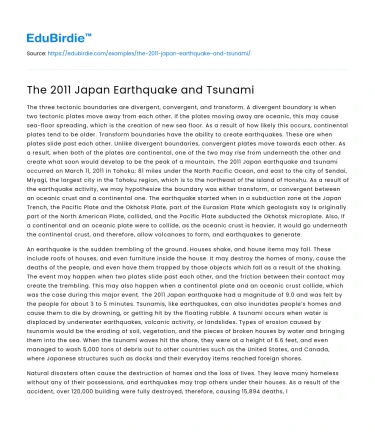The three tectonic boundaries are divergent, convergent, and transform. A divergent boundary is when two tectonic plates move away from each other. If the plates moving away are oceanic, this may cause sea-floor spreading, which is the creation of new sea floor. As a result of how likely this occurs, continental plates tend to be older. Transform boundaries have the ability to create earthquakes. These are when plates slide past each other. Unlike divergent boundaries, convergent plates move towards each other. As a result, when both of the plates are continental, one of the two may rise from underneath the other and create what soon would develop to be the peak of a mountain. The 2011 Japan earthquake and tsunami occurred on March 11, 2011 in Tohoku; 81 miles under the North Pacific Ocean, and east to the city of Sendai, Miyagi, the largest city in the Tohoku region, which is to the northeast of the island of Honshu. As a result of the earthquake activity, we may hypothesize the boundary was either transform, or convergent between an oceanic crust and a continental one. The earthquake started when in a subduction zone at the Japan Trench, the Pacific Plate and the Okhotsk Plate, part of the Eurasian Plate which geologists say is originally part of the North American Plate, collided, and the Pacific Plate subducted the Okhotsk microplate. Also, if a continental and an oceanic plate were to collide, as the oceanic crust is heavier, it would go underneath the continental crust, and therefore, allow volcanoes to form, and earthquakes to generate.
An earthquake is the sudden trembling of the ground. Houses shake, and house items may fall. These include roofs of houses, and even furniture inside the house. It may destroy the homes of many, cause the deaths of the people, and even have them trapped by those objects which fall as a result of the shaking. The event may happen when two plates slide past each other, and the friction between their contact may create the trembling. This may also happen when a continental plate and an oceanic crust collide, which was the case during this major event. The 2011 Japan earthquake had a magnitude of 9.0 and was felt by the people for about 3 to 5 minutes. Tsunamis, like earthquakes, can also inundates people’s homes and cause them to die by drowning, or getting hit by the floating rubble. A tsunami occurs when water is displaced by underwater earthquakes, volcanic activity, or landslides. Types of erosion caused by tsunamis would be the eroding of soil, vegetation, and the pieces of broken houses by water and bringing them into the sea. When the tsunami waves hit the shore, they were at a height of 6.6 feet, and even managed to wash 5,000 tons of debris out to other countries such as the United States, and Canada, where Japanese structures such as docks and their everyday items reached foreign shores.
Save your time!
We can take care of your essay
- Proper editing and formatting
- Free revision, title page, and bibliography
- Flexible prices and money-back guarantee
Natural disasters often cause the destruction of homes and the loss of lives. They leave many homeless without any of their possessions, and earthquakes may trap others under their houses. As a result of the accident, over 120,000 building were fully destroyed, therefore, causing 15,894 deaths, leaving over 2,500 people missing, and as of 2017, 50,000 people still had short-termed shelter. The total cost from the accident was calculated by the World Bank to be over $235 billion dollars. After natural disasters occur, money is allotted by the government especially for the reconstruction of buildings, and a cleanup of the area damaged. Often, a center for registering missing people is also set up, and the government may assist homeless families in finding shelter. Another of the major negative results of the event was when the earthquake and the tsunami shut down nuclear power stations in Tohoku, damaged the backup generator of the station called Fukushima Daiichi, and caused the system to overheat, therefore, melting the pipes and causing holes on the station, which lead to explosions and a release of radiation.
To increase awareness of natural disasters such as these and prepare for the next event, people may read educational guides on what to do in case of an emergency, and even form safety plans of evacuation with their families. They may also have a toolkit with their most important possessions just in case they need to quickly leave their homes. Residents near areas of danger, when warned, should not underestimate the possible danger. Also, those who receive alert of a tsunami in their region, should move to higher ground as soon as possible. To prepare better for any future catastrophes, Japan delivered a new tsunami warning system, engineers tried finding a way in which buildings could be more resistible to both tsunamis and earthquakes, and worldwide researchers put sensors along fault lines to identify the cause of the earthquake.






 Stuck on your essay?
Stuck on your essay?

